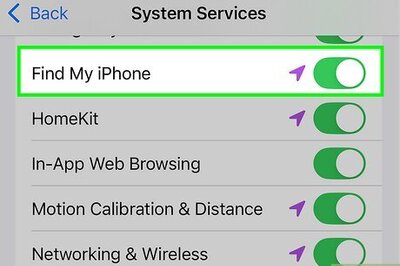
views
Mumbai has received 253.3 mm rainfall in the 24 hours ending 8 am on Friday, making it the city’s third highest single-day rainfall in July in the last 12 years, the IMD data has revealed. This 24-hour period rainfall was recorded by India Meteorological Department’s Santacruz observatory in the state capital. On July 15, 2009, Mumbai had received 274.1 mm rainfall, while on July 2, 2019, it had recorded 376.2 mm rainfall, the IMD records showed.
The Friday morning’s rain was concentrated largely over the western suburbs and parts of central Mumbai. The data for the day shows large discrepancies in spatial distribution, which experts have attributed to easterly winds that pushed the cloud away from south Mumbai, Hindustan Times reported.
As a result, IMD’s observatory in Colaba recorded only 13mm rainfall during 24-hour period till Friday morning. Both the observatories also pointed out that Mumbai has received more rains than its average rainfall.
“We’re still not entirely sure why this happened. Radar images from late on Thursday did not show any indication of thunderstorm formation. In the absence of typical large-scale features such as a deep layer of winds from the west over Mumbai, a monsoon low-pressure system over east or central India, or a vigorous offshore trough, even weather models would not have been able to predict this,” Akshay Deoras, independent meteorologist and PhD student at University of Reading reportedly said.
The Santacruz observatory has reported a departure of 609.1 mm rainfall as it has recorded 1,544.9 mm rainfall since June 1. Similarly, the Colaba weather station has reported a departure of 132.68 mm rainfall as it has received 1,068.4 mm rainfall since June 1.
Why is the Rainfall Unusual This Time?
Friday’s rainfall in Mumbai is likely to be the “first event of this magnitude in this century to have been triggered in the absence of any Bay of Bengal monsoon low-pressure system in the month of July,” Akshay Deoras said.
According to Deoras, the mountainous terrain in Mumbai’s suburbs — specifically the Sanjay Gandhi National Park and other areas nearby– may have contributed to the formation of the intense thunderstorm earlier in the day. Such thunderstorms are common in the city during pre-monsoon season in early June, but not in July, when heavy rains are driven by low-pressure systems and strong offshore trough.
With a total seasonal rainfall of 1545mm, Mumbai has now surpassed the expected normal rainfall amount till end July, which is 1332.5mm. The normal rainfall between June 1 and July 16, as per IMD, is 935.8mm. Mumbai has received rainfall that is 65% in excess of the normal, up to July 16.
Predictions for Next Week
Reports say that it is unclear how the rains will play out over the next week or in the remainder of this month. The broader scenario is not conducive for a high frequency of such intense rainfall events, which are typically seen in July.
Meanwhile, independent meteorologists have pointed out that prevailing wind patterns- opposing easterly and westerly winds- which kept rains away from Mumbai city also continue. Mumbai has been placed under a yellow category storm warning alert for today, indicating heavy rain at isolated places.
IMD, however, has placed Mumbai under an orange category storm warning alert from July 18 to 20, indicating “heavy to very heavy rain at isolated places” and chances of extremely heavy rainfall.
On the other hand, Independent forecasters agree that the monsoon will continue to remain active between July 17 and 22.
Why IMD couldn’t forecast Friday’s Rain?
Jayanta Sarkar, head of the IMD’s regional forecasting centre in Mumbai, said there are two components of forecasting- intensity and distribution; and added that they predicted the distribution correctly, but the intensity could not be predicted since the cloud cover formed extremely quickly in the morning.
Forecasters say that Friday’s thunderstorm was near impossible to predict but they also criticised IMD for poor functioning of its doppler radar in Colaba. Forecasters say that the radar had become defunct during heavy showers on Wednesday and has been scanning images at intervals of every 45 minutes. They say that a higher scan frequency would provide more actionable data for stakeholders during unexpected extreme weather events.
Read all the Latest News, Breaking News and Coronavirus News here.




















Comments
0 comment